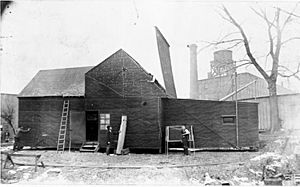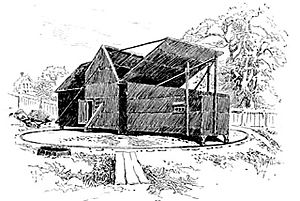Edison's Black Maria facts for kids
The Black Maria was the world's very first movie studio! It was built by famous inventor Thomas Edison in West Orange, New Jersey, a town in New Jersey. This special building was where the first movies were ever made.
Contents
The First Movie Studio
The Black Maria was finished in 1893. It was built at Edison's laboratories in West Orange, New Jersey. Its main job was to create short films for a new invention called the Kinetoscope.
Building the studio started in December 1892. It was ready the next year. The Black Maria had a dark room covered in tar-paper. It also had a roof that could open up.
First Public Movie Show
In May 1893, Edison showed his new films to the public. This happened at the Brooklyn Institute of Arts and Sciences. People watched the films using a Kinetoscope viewer. The first film showed three people pretending to be blacksmiths.
The very first movies made at the Black Maria were officially registered. W. K. Dickson submitted them for copyright in August 1893. One famous early film was Fred Ott's Sneeze from 1894. It showed Edison's assistant, Fred Ott, sneezing. This film was used to promote movies in a magazine. It was one of the first movies ever copyrighted.
What Kinds of Movies Were Made?
Many different kinds of films were shot at the Black Maria. There were magic shows and short plays. People watched vaudeville acts with dancers and strongmen. Even parts of Buffalo Bill's Wild West Show were filmed there.
Early films also showed boxing matches. After 1895, many films showed "actualities." These were real-life scenes. They included street views, police or firemen working, and trains passing by.
Kinetoscope Parlors Open
On April 14, 1894, Edison's Kinetoscope started making money. The Holland Brothers opened the first Kinetoscope Parlor. It was in New York City. For the first time, people could pay to watch movies.
Customers paid 25 cents to see films in five Kinetoscope machines. Almost 500 people became the first big movie audience. They watched films like Barber Shop and Cock Fight. The Black Maria studio made all the films for this exciting new entertainment. Soon, more Kinetoscope parlors opened in other cities.
Why the Black Maria Closed
The Black Maria was used until January 1901. Edison then built a new, glass-enclosed studio in New York City. The Black Maria building was taken down in 1903.
The people who worked there said it was a small and uncomfortable place. Edison's employees called it the "Black Maria." This was because it reminded them of police vans, which were also black and cramped. Edison himself called it "The Doghouse," but that name did not stick.
The studio was covered in black tar-paper. It had a huge window in the ceiling. This window opened to let in lots of sunlight. Early films needed a lot of bright light to be made. The Black Maria was built on a turntable. This meant the window could turn to follow the sun all day. This gave natural light for hundreds of movies over eight years.
When news spread about this new invention, performers came from everywhere. They wanted to be in the films. These silent movies featured dancers, boxers, magicians, and vaudeville stars. Edison often posed with these performers for newspaper articles. This helped to promote his new movies.
Rebuilding the Studio
The Black Maria was not used anymore when movie making moved to New York. The Edison company took the studio apart in 1903.
In 1954, the Thomas Alva Edison Foundation built a copy of the Black Maria. It was built on the same spot as the original. This rebuilt studio showed films to the public until the 1980s.
In 2022, the National Park Service started fixing up the building. They made many repairs and added a new outside. They also added a ramp to make it easier to visit. The Black Maria opened again in April 2024. It now has new exhibits and displays. Visitors can even use period clothing to make their own films and take selfies!
Movies Made at the Black Maria
- Blacksmith Scene (1893)
- Washing the Baby (1893)
- Edison Kinetoscopic Record of a Sneeze, also known as Fred Ott's Sneeze (1894)
- The Boxing Cats (Prof. Welton's) (1894)
- The Dickson Experimental Sound Film (1894/95)
- Fun in a Chinese Laundry (1896)
- Sioux Ghost Dance
- Buffalo Bill's Shooting Skill
- Cripple Creek Bar-Room Scene
See also
 In Spanish: Black Maria para niños
In Spanish: Black Maria para niños




